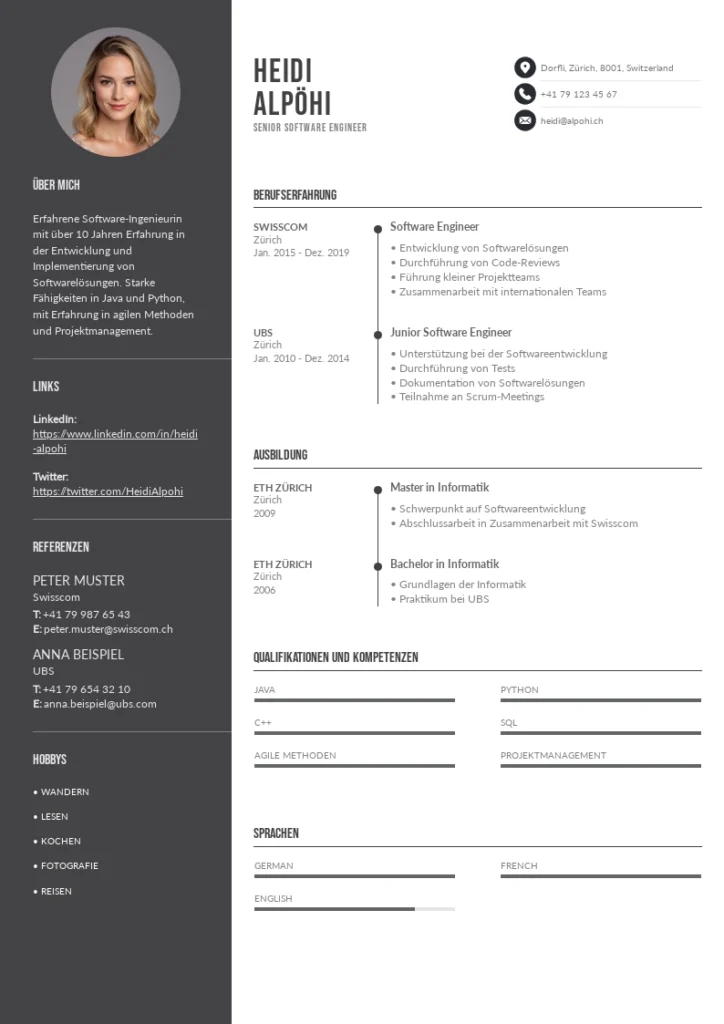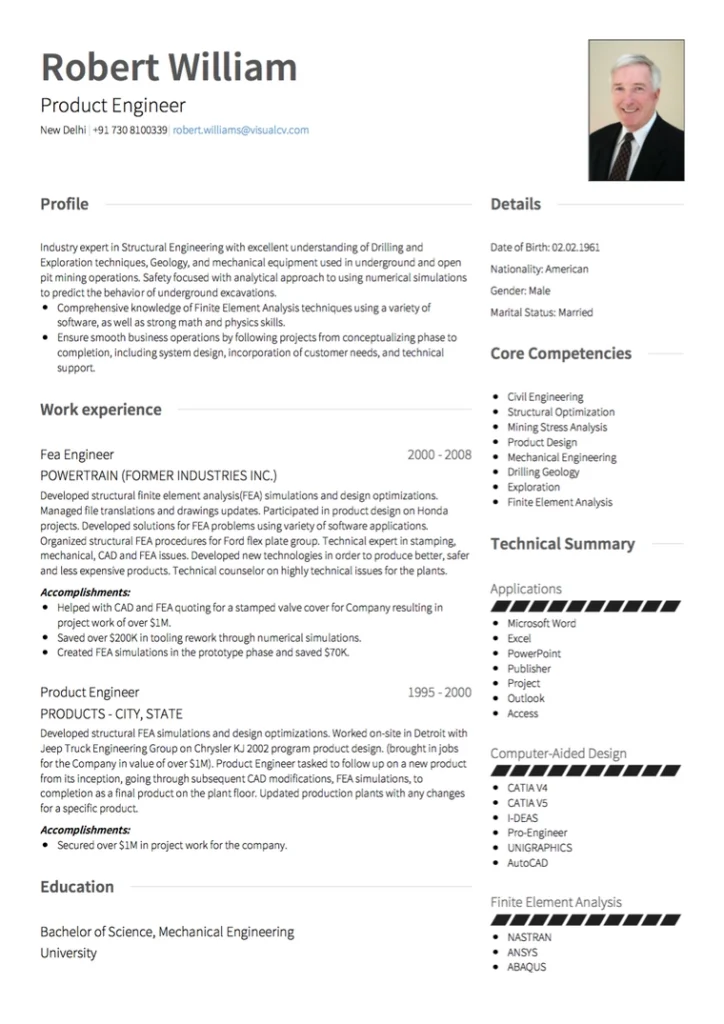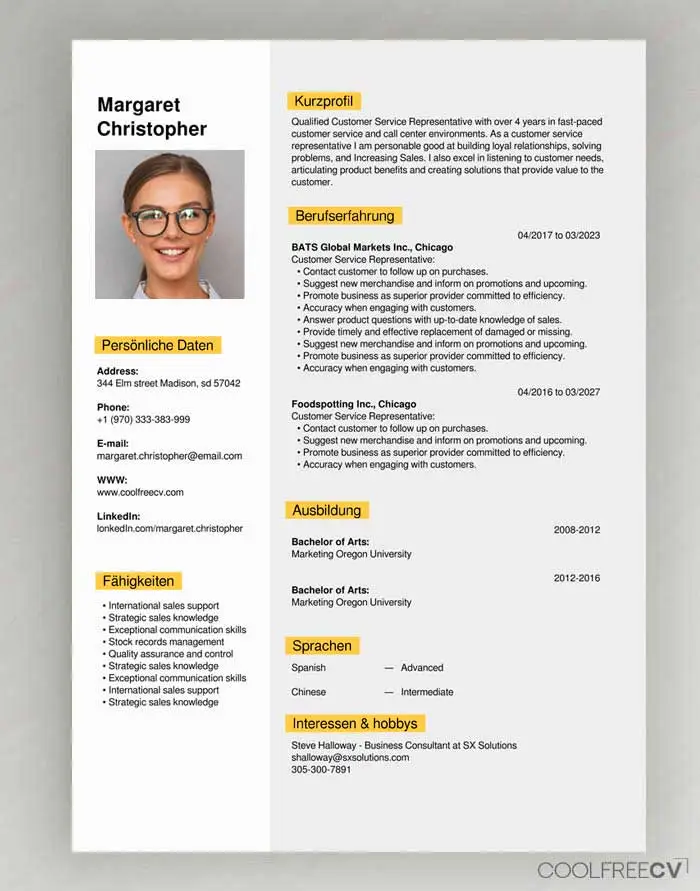TL;DR — Quick Takeaways for Your Swiss CV
- Use a clean, ATS-friendly format without decorative templates or graphics, so your CV passes the first automated screening and reaches a real recruiter.
- Include a professional photo, ideally with neutral lighting and business-appropriate clothing, because Swiss employers still expect it as part of a complete application.
- Keep your CV short and focused. One page is enough for juniors, while experienced professionals can use two or three pages if the content is relevant.
- Follow a reverse chronological structure, starting with your most recent role, and highlight achievements with clear, measurable results instead of long paragraphs.
- Adapt your keywords and job titles to reflect the language of the job description, helping your CV match Swiss terminology and increasing your chances of being shortlisted.
- Make your layout uniform and visually balanced, with consistent spacing, fonts, and section headers — Swiss recruiters value structure and clarity above all else.
- Remove unnecessary personal details such as full address, marital status, or hobbies unless they directly support your application or are culturally relevant.

If you’re looking for a Swiss CV example that truly gets noticed by employers, understanding the local expectations from layout to photo is key. Over the years as a career coach in Zurich, I’ve seen so many talented international professionals struggle to get interviews, not because they lack skills, but because their CV doesn’t speak the Swiss language of precision and clarity.
In Switzerland, even the smallest details matter. The Lebenslauf (that’s the German term for CV) is expected to be concise, well-structured, and visually balanced. Employers here are famously detail-oriented. They notice if your formatting is inconsistent, if your layout looks cluttered, or if your photo feels too casual.
And while in other countries you might get away with creative templates or long summaries, Swiss recruiters prefer simplicity, structure, and relevance.
If you’re an expat or foreign job seeker, adapting your CV to these local expectations can instantly improve your chances of getting interviews.
Understanding the Swiss Recruitment Process
Before you send out your CV, I want you to understand how recruitment actually works in Switzerland. Many talented professionals never get called simply because their CV doesn’t make it past the first stage.
Switzerland has a very structured recruitment system, and much of this is publicly explained on the official Swiss job market portal operated by the State Secretariat for Economic Affairs (SECO).
Here’s what typically happens when you apply for a job in a Swiss company:
1. ATS (Applicant Tracking System) Screening
Your CV is first processed by an automated system that scans for keywords, structure, and compatibility. If your CV isn’t formatted correctly or lacks the right terminology, it may never reach a human recruiter.
When the system recognizes a good match, your application moves forward and is reviewed by HR, who then look more closely at your experience, presentation, and overall fit for the role.
2. HR Evaluation
Once your CV passes the ATS, it’s reviewed by HR, who check for clarity, relevant experience, and cultural fit. This is where a professional photo and a clear layout make a strong impression. HR usually scans your profile quickly to see if your background aligns with the role, so having a well-structured CV helps them understand your strengths at a glance.
If everything matches what they’re looking for, your application moves forward to the interview stage.
3. Interview Stage
Selected candidates are invited for one or more interviews, often a first round with HR and a second with the hiring manager or team lead. Swiss interviews are structured and punctual, and both preparation and precision matter.
You can expect clear questions about your experience, specific examples of your achievements, and how you handle real work situations. Interviewers also pay attention to how well you understand the company and the role, so doing your research makes a strong impact.
4. Job Offer & Negotiation
If the interviews go well, you’ll receive a written offer outlining your role, salary, and benefits. You’ll have the chance to review the details, ask questions, and clarify anything that matters to you before accepting.
Once you sign the offer, the company will guide you through the onboarding steps, including paperwork, start dates, and any documents they need from you.
5. Final Agreement & Onboarding
After signing the employment contract, onboarding is typically well-organized and formal, which reflects the high level of Swiss professionalism. New employees are usually given a clear schedule, access to the necessary systems, and an introduction to the team.
You can expect structured guidance during your first days so you understand your role, responsibilities, and the company’s expectations from the start.
That’s why I always remind my clients that your CV isn’t just a formality. It’s your first test in this structured system. If it doesn’t meet Swiss standards, it may never get to the interview stage, no matter how qualified you are.
ATS-Friendly Swiss CV Format (With Examples)
When it comes to job applications, Switzerland values precision above all else, and your CV should reflect that. The CV format in Switzerland emphasizes clarity and simplicity. You may be thinking, “How do I optimize my CV for the Swiss market?” and that’s exactly what you need to get right if you want to stand out.
That means:
- no fancy templates
- no decorative fonts
- and no distracting colors
Just a clear, professional structure that lets your experience speak for itself.
Your Swiss CV should be concise, factual, and visually clean. Ideally, it should fit on one to two pages, never more. Swiss recruiters appreciate efficiency and they want to see your most relevant achievements, not every task you’ve ever done.
The structure follows a clear chronological order, with your most recent experience first, followed by education, languages, and technical skills. Fonts like Arial or Calibri in 10 to 11 pt size keep everything neat and easy to scan.
When I review CVs from international professionals, this is often where I see the biggest gap. The content might be impressive, but the layout doesn’t match local expectations. In Switzerland, presentation is part of your professionalism.
Most large Swiss companies use advanced HR systems such as Workday, which scan CVs for specific terminology and structure. This makes it essential to keep your layout clean and ATS-friendly.
Also, if you want step-by-step help with your CV format, you can join my 3-Day Swiss CV Success Challenge.
Ideal Swiss CV Length and Structure
One of the most common questions I hear from my clients is about CV length in Switzerland, and here is my answer. If you’re a recent graduate or early in your career, one page is accepted. For experienced professionals, two pages is the standard, and in academic fields it can even extend to three.
Regarding the structure of your CV, it should allow recruiters to understand your background at a glance.
Here’s the structure I recommend for a Swiss-style CV:
- Personal information (name, contact details, residence permit, LinkedIn)
- Professional summary (optional, 3–4 lines highlighting your value)
- Work experience (most recent first, with clear dates and accomplishments-oriented)
- Education and certifications
- Skills and technical expertise
- Languages (with proficiency levels)
- References
Swiss recruiters often have 5 seconds to scan a CV to decide if it should go to the next round or not, so remember to keep your layout clean and highlight your most relevant achievements first.
Should You Include a Photo on Your Swiss CV?
Many international professionals wonder if they should include a photo on their CV in Switzerland. The answer is absolutely yes, as long as it looks professional and aligns with Swiss standards.
Unlike in the UK or US, where photos are often discouraged, in Switzerland a professional headshot is still considered part of a complete CV. It helps employers put a face to your name and conveys professionalism when done right.
Your photo should look polished but natural:
- Formal or smart-casual business attire
- Neutral background (light grey, beige, or white)
- Friendly yet confident expression
- No selfies, filters, or cropped vacation photos
I always tell my clients that your photo does not need to make you look perfect. It just needs to make you look approachable, trustworthy, and professional. Think of it as your first handshake with a Swiss employer.
At Advanced Talent, we also offer personal branding photo sessions for LinkedIn, websites, or CVs. You will leave the session feeling comfortable, self-assured, and proud of how you show up.
If you need help creating your CV, you can reach out here to schedule a session with me.
Swiss CV Templates That Aren’t Helpful
If you have ever typed Swiss CV example into Google, you have probably seen dozens of templates that look sleek but would not actually get you interviews in Switzerland. I see this mistake all the time, CVs that look modern but fail to follow Swiss conventions in structure, tone, and format.
When I review applications from international professionals, I often find that the format they copied online is visually attractive but culturally off, and that is enough for recruiters here to skip it. Many so-called “Swiss CVs” use overly designed templates, creative layouts, or vague summaries that simply do not fit what local employers expect.

This format is not ATS-compatible

This format is not ATS-compatible

This format is not ATS-compatible
What Are Some Common Mistakes to Avoid When Writing a CV for a Job in Switzerland?
After reviewing hundreds of CVs from international professionals, I have noticed the same patterns that quietly cost candidates their interviews. If you want your application to stand out in Switzerland, avoid these common pitfalls:
- Including too much personal information – You don’t need your full address, marital status, children, or a long list of hobbies. Keep it professional and relevant.
- Writing long paragraphs instead of bullet points – Swiss recruiters scan CVs quickly. Use short, clear bullet points that highlight measurable results.
- Using American or British formatting – The Swiss CV has its own style: dates come first (MM/YYYY), sections are minimalistic, and design is simple.
- Ignoring local language differences – A CV for Zurich might need to include some German terms, while in Geneva, French is preferred. It shows cultural awareness.
- Not including a photo when it’s expected – In most regions of Switzerland, a clean, professional photo still matters. Leaving it out can make your CV feel incomplete and lack cultural understanding.
These may seem like small details, but in Switzerland, small details are what separate good applications from successful ones.
Tips to Make Your Swiss CV Stand Out
Once your CV follows the right Swiss format, it’s time to fine-tune it so it actually stands out. Here are a few simple but powerful tweaks I always recommend to my clients:
- Adapt your CV for each role. Tailor your keywords to match the job posting because Swiss recruiters expect alignment between your title, skills, and their requirements.
- Show measurable results. Add achievements that demonstrate impact: “Increased efficiency by 20%” or “Managed projects across 3 cantons.” Numbers and outcomes speak louder than adjectives.
- Use the appropriate language for your CV. If you’re applying in German- or French-speaking regions, make sure your CV matches the local language — it shows respect and cultural awareness.
- Get a professional review. Sometimes a small structural or language tweak makes all the difference.
If you would like a personalized Swiss CV review to maximize your chances, you can schedule a 20-minute consultation with me. It is your space to ask anything about how to land a job in Switzerland, from adapting your CV and positioning your skills to understanding what Swiss employers really look for.
Please note: At Advanced Talent, we focus on career strategy and coaching. We don’t guarantee job placement or actively find positions for candidates — instead, we help you build the tools, mindset, and strategy to succeed on your own in the Swiss market.
FAQs About Swiss CVs
Q1: What is the correct CV format in Switzerland?
The correct format follows a chronological structure, with full pages, a clean and simple layout, and a professional photo. Avoid creative templates or colorful designs because Swiss recruiters value clarity and structure.
Q2: Should I include a photo on my CV in Switzerland?
Yes. A professional headshot is still standard practice in Switzerland, especially in German-speaking regions like Zurich. It helps create a trustworthy first impression.
Q3: How long should a Swiss CV be?
Keep your CV short. One page is enough for juniors, and two or three pages work for experienced professionals. Recruiters here appreciate concise and relevant information.
Q4: Do Swiss companies prefer German CVs?
It depends on the region. In Zurich and most of German-speaking Switzerland, German is preferred; in Geneva and the French-speaking cantons, French is standard.
For multinational companies, English CVs are usually accepted. The number one rule is that the CV should follow the language of the job description.
Q5: Where can I find a Swiss CV example?
You will find many templates online labeled as “Swiss CV,” but unfortunately most of them are not compatible with ATS (Applicant Tracking Systems), and that is one of the biggest sources of confusion for job seekers. These visually impressive designs often get automatically filtered out before a recruiter even sees them.
That’s why I always recommend getting guidance from reliable sources. You can contact job-search services offered by your canton’s municipality or work with a certified career coach who understands Swiss market standards.
You can also reach out to me directly if you’d like help fine-tuning your CV to make sure it’s both ATS-friendly and aligned with local expectations.
Final Tips to Make Your Swiss CV Stand Out
Swiss CVs are all about clarity, structure, and professionalism. When you understand what Swiss employers value, such as precision, a clean layout, and relevance, you are already one step ahead of most applicants.
Keep your CV concise, use a professional photo, and follow the local expectations for formatting and tone. These details may seem small, but in Switzerland, they make all the difference between being overlooked and being invited to an interview.
By following this Swiss CV example and layout guide, you’ll stand out from other candidates and land interviews faster.
If you’d like personalized guidance to make sure your CV is fully aligned with Swiss standards, you can schedule a 20-minute consultation with me. We’ll review your application strategy, fine-tune your CV, and clarify your next steps for landing a job in Switzerland.
Let’s work together to make your application Swiss-ready, clear, confident, and designed to get interviews.



